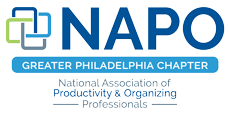The Philadelphia Hoarding Task Force, a coalition seeking to improve the outcomes surrounding hoarding issues, hosted a hoarding intervention workshop led by Jesse Edsell-Vetter. Jesse presented an innovative intervention model that he has developed and implemented with an impressive 98% success rate. The key to his model is the shift of focus from the “stuff” to the person.
In the past, Jesse, a Case Management Specialist with the Metropolitan Boston Housing Partnership, had used a common approach when dealing with hoarded homes. He would explain the health and safety issues and cite the code violations that had to be resolved to prevent eviction. After leaving the person alone to address these issues, follow-up meetings predictably showed little-to-no progress. A clean-out was the inevitable next step, costing an average of $10,000. Over time, Jesse observed the homes return to their hoarded state. Focusing solely on the clutter has proven to be extremely costly and unsustainable as a treatment option. Beyond the monetary cost, the emotional trauma is also a factor. In one tragic example, a family returned to their home after the clean-out and committed suicide.
In response, Jesse shifted his approach from focusing on the “stuff” to focusing on the person: who they are, their commitments, their struggles and what moves them. For the majority of us, life’s challenges leave scars and hurts that dissipate with time. For people with hoarding behavior, woven in the items they hoard are their scars on display for all to see and judge. While a clean-out removes the “stuff,” it does nothing to unlock the stories and hurts interwoven in the piles. Jesse’s model, in contrast, coaxes these stories out with respectful, compassionate and nonjudgmental interactions emphasizing the human side of the clutter, lessening the grip of extreme hoarding habits.
During the workshop, Jesse shared a case study about Bob, an elderly man challenged with health problems, living alone, facing eviction, and surrounded by paper piles, some as high as seven feet tall. Rather than mandate compliance to codes and leave Bob alone to manage his stuff, Jesse explained the safety requirements to Bob and asked how he could help. Jesse gained Bob’s trust with empathic statements like, “I worry that X” and “I am concerned because Y.” As Jesse rolled up his sleeves and sorted through the piles with Bob, he asked questions such as, “Tell me about your X” or “Tell me about these papers I see.” This technique of “curious questioning” revealed Bob’s vulnerabilities (mental and physical health, traumas, and family history), his cognitive processes (problem solving, attention, and executive functioning skills) and his core beliefs (values, responsibilities, and how he sees his place in the world). Jesse learned that Bob came from a very religious family. Three of his sisters were nuns, and he himself had wanted to be a priest. Struggling with his sexuality, at age 20 Bob told his family he was gay. He was then shunned by his family and his religious community. Fast forward from that time in the early 1960’s to the present day, Bob’s apartment was a manifestation of that devastating loss. One item Bob hoarded was church bulletins. He attended church services every day, each day taking copies of the bulletin with the intention of sharing them with others. From the overwhelming piles, it was obvious though that this rarely happened. Using a team approach, a cornerstone of his intervention model, Jesse invited Bob’s priest to collaborate. Seeing how committed Bob was to his religion, the priest asked Bob to assist him in providing communion to people who were unable to attend church. In that moment, Bob recovered his purpose in life and adopted a healthier expression of his deep connection to his church and community.
Bob’s story illustrates the human side of Jesse’s 98% success rate, showing what’s possible when we leave our judgments at the door, stop addressing the person’s “stuff” and instead, unlock the stories and hurts buried in the hoarded piles. When intervention models lead with the threat of a clean out, walls go up, but, as Jesse has shown, when the intervention is infused with respect, non-judgment, curious questioning, statements of concern, clearly articulated expectations and actions, motivation and genuine praises for milestones met, partnership and collaboration becomes possible and the work of letting go and healing begins. In Bob’s case, when the priest invited Bob to help him, Bob was able to connect to his life again and the importance of his “stuff” could take a back seat.





